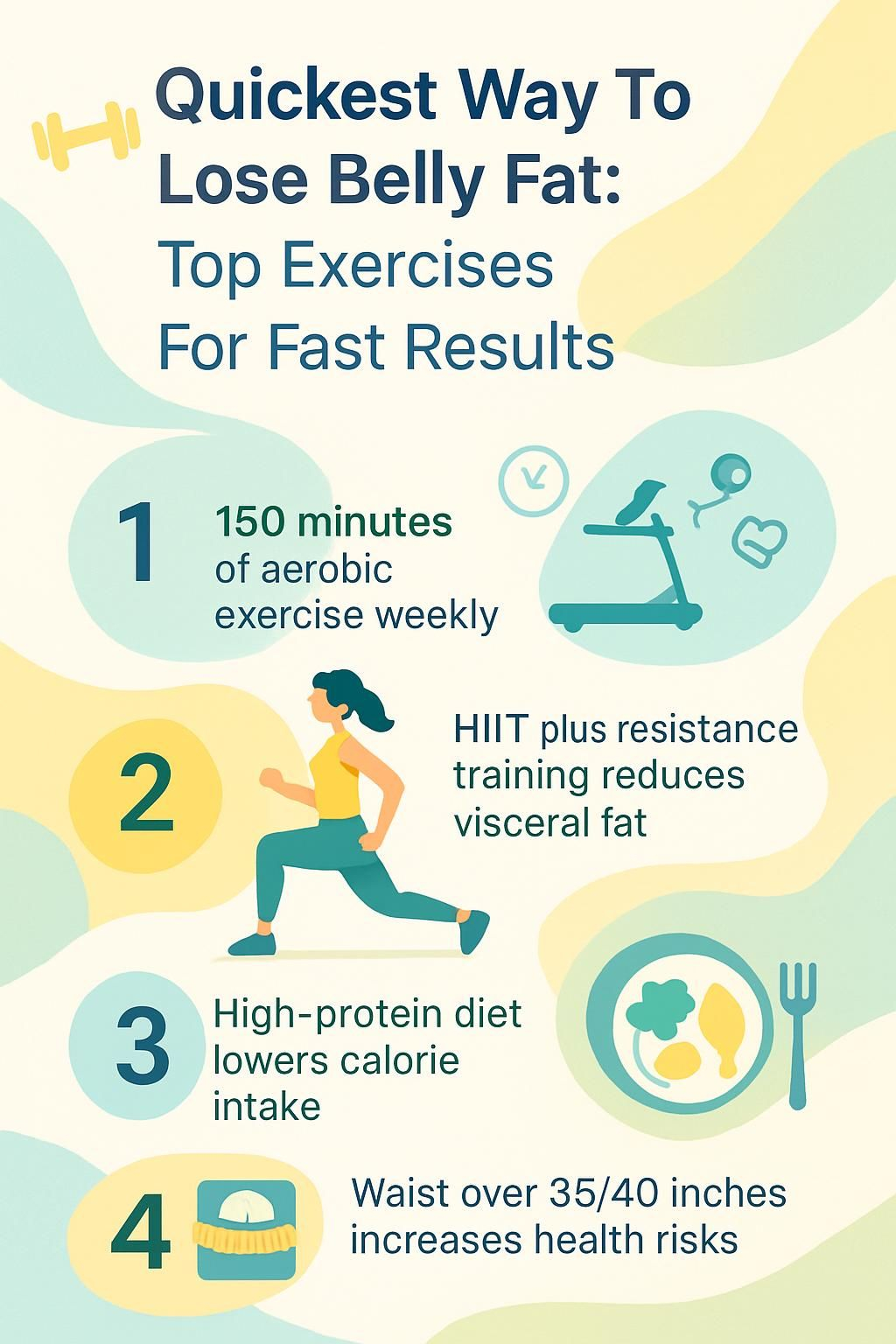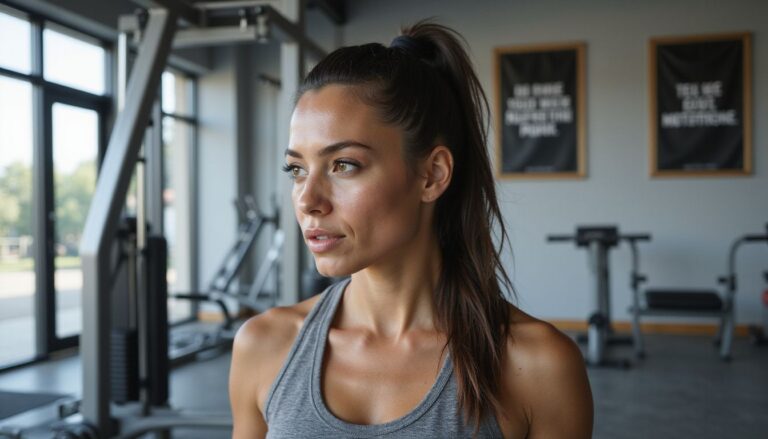Quickest Way To Lose Belly Fat: Top Exercises For Fast Results
Our Nutrition Assistant AI Suite will transform your body. You will lose fat, get toned, and build muscle. Gain confidence and optimal health.
Trying to shrink a stubborn waistline can feel frustrating. Larger waist sizes raise the risk of heart disease and type 2 diabetes. The right plan helps you lose belly fat faster and protects your health at the same time.
This guide shows the most effective exercises to lose belly fat, plus habits that speed results. You will learn what works, what to skip, and how to track progress without guesswork.
Keep reading for fast, realistic results you can maintain.
Key Takeaways
- Aerobic exercise such as brisk walking, running, swimming, or cycling for at least 150 minutes a week helps cut both visceral fat, the fat around organs, and subcutaneous fat under the skin.
- Pairing High-Intensity Interval Training, HIIT, with resistance training reduces visceral fat more than steady cardio or dieting alone.
- A high-protein eating pattern preserves muscle mass, controls hunger, and supports a lower calorie intake. Limiting refined carbs and added sugar lowers the risk of abdominal obesity and type 2 diabetes.
- Waistlines over 35 inches for women and 40 inches for men are linked to higher risks of heart disease, fatty liver, sleep apnea, and some cancers.
- Consistent workouts, better sleep, less stress, and steady routines help you lose fat around your belly faster and keep it off.

Types and Health Risks of Belly Fat

Not all belly fat is the same. Understanding the two types helps you pick smarter strategies and set better goals.
What are the differences between visceral and subcutaneous belly fat?
Subcutaneous fat sits just under the skin. You can pinch it. Visceral fat lives deeper in the abdomen and wraps around the liver, pancreas, and intestines.
A hard, round belly often signals more visceral fat. Doctors worry about visceral fat because it raises health risks more than the soft fat under the skin.
High levels of visceral fat are tied to heart disease, insulin resistance, type 2 diabetes, and some cancers. Subcutaneous fat is less risky unless total body fat gets very high.
Health groups suggest keeping waist size under 35 inches for women and under 40 inches for men to lower risk.
“After menopause my weight stayed stable, but my waist grew,” says Sarah T., 54. “Learning about visceral fat pushed me to add steady cardio and strength work, and my waist started shrinking.”
What health problems are linked to excess belly fat?
Carrying extra abdominal fat raises the chance of type 2 diabetes, high blood pressure, and metabolic syndrome. Heart disease and stroke risk climb as waist size grows.
People with excess visceral fat also face higher rates of sleep apnea, fatty liver disease, certain cancers like colorectal cancer, and early death. Blood vessel function can worsen, which may lead to narrowed arteries and poor circulation.
High belly fat often comes with high blood sugar and unhealthy cholesterol levels. For those who are overweight or obese, trimming the waist can improve lung function during activity and may improve sleep quality.
Why Is Exercise Important for Losing Belly Fat?
Think of exercise as a daily spark for your metabolism. It helps your body use stored energy, including fat around your belly.
How does physical activity help reduce belly fat?
Physical activity increases how many calories you burn each day. Aerobic exercise like walking, running, and cycling raises your heart rate and pushes your body to use fat for fuel.
Research supports at least 150 minutes of moderate aerobic activity per week to reduce abdominal fat. In one study, postmenopausal women who exercised 300 minutes per week lost more total fat than those who did half as much.
Regular movement can lower insulin and cortisol levels. Lower insulin helps your body use stored fat. Lower cortisol, a stress hormone, is linked with less deep belly fat. Combining strength training with cardio is especially effective for shrinking visceral fat.
“Sometimes the best way to burn off extra energy is simply moving a little more each day.”
Pair exercise with smart eating for faster and more lasting results.
How does combining exercise with a healthy diet improve fat loss?
Exercise burns calories and keeps muscle. A balanced diet sets the stage for steady loss by preventing overeating. Together they work better than either alone.
In a Johns Hopkins trial, a lower carb approach led to greater weight loss over six months than a low fat plan. Keeping carbs in check while training helps your body burn more fat and keep lean muscle.
Build meals around protein, vegetables, fiber-rich carbs, and healthy fats. Mix resistance training with aerobic days. I saw my waist drop faster once I tracked protein and alternated HIIT with brisk walking.
Top Exercises to Lose Belly Fat Quickly
Use a mix of cardio, intervals, and strength. Variety keeps you consistent and targets different parts of fitness.
What aerobic exercises help burn belly fat?
Aerobic exercise, steady activity that raises your heart rate, is a direct way to lose fat around your belly. Try these options and choose two or three you enjoy.
- Brisk walking, 30 minutes most days, trims your waist and is easy to maintain.
- Running, 20 to 30 minutes three to four times a week, uses stored fat for energy.
- Cycling works large leg muscles and boosts calorie burn. A stationary bike is a convenient indoor choice.
- Swimming trains the whole body and is gentle on joints. Aim for 150 minutes a week.
- Group classes, such as dance cardio or kickboxing, make workouts fun and social.
- HIIT, short hard bursts with brief rests, may reduce belly fat faster than steady cardio.
- Jump rope raises heart rate quickly and engages your core.
Back in college I gained inches around my middle. Adding runs and simple HIIT intervals helped me lean down within a few months.
How effective is walking for losing belly fat?
Walking is one of the easiest ways to start losing belly fat. It is low impact, flexible, and works for most fitness levels.
Walk at a moderate pace for 30 to 60 minutes on most days. This helps reduce both the fat you can pinch and the deeper visceral fat. Healthy adults should target at least 150 minutes of moderate aerobic activity each week.
Track progress with a tape measure and by how your clothes fit. Pair daily walks with a high-protein diet that is low in refined carbs and added sugar to improve body composition.
Can running help reduce belly fat quickly?
Running burns more calories per minute than walking. Regular runs can lower insulin levels, which encourages your body to use stored fat, including stubborn visceral fat.
Start with 75 minutes of vigorous cardio a week, such as three 25-minute runs. Add one or two strength sessions to protect muscle as you lose weight.
Short fast intervals push fat burning even higher. Keep your schedule consistent. Skipping runs slows progress, even if earlier weeks went well.
Is cycling a good exercise for belly fat loss?
Yes. Cycling is an effective, joint-friendly way to burn calories and reduce abdominal fat. You can ride outdoors or use a stationary bike.
Target at least 150 minutes per week at a moderate effort. Cycling strengthens the heart and improves blood vessel health. Pair rides with basic strength work to shape your body and guard muscle.
I began with short evening rides. After three months my waist dropped two inches, thanks to consistent biking and more fiber from plants at meals.
How does swimming contribute to belly fat reduction?
Swimming trains your whole body and burns calories quickly. It counts as moderate or vigorous cardio depending on pace. Both support fat loss around your midsection.
Water workouts are gentle on joints, which helps if you have knee or back pain. Building lean muscle from swimming also raises resting calorie burn.
Regular pool time can lower stress and improve heart and metabolic health. Many people combine swimming with light strength days to speed results.
What is High-Intensity Interval Training (HIIT)?
HIIT is a training style with short bursts of hard effort followed by brief rest. You can apply it to running, cycling, swimming, or bodyweight moves like push-ups and mountain climbers.
Because effort is high, sessions are short, often 15 to 30 minutes. Studies show HIIT can reduce belly fat and improve metabolic health in less time than steady cardio.
Trainers use HIIT to target visceral fat while preserving muscle. It is efficient and scales to different fitness levels.
Why is HIIT beneficial for burning fat fast?
HIIT spikes your heart rate and keeps your metabolism elevated after the workout. That afterburn helps you use more calories during recovery.
Research in teens with excess weight found that mixing aerobic and strength training, including high-intensity work, led to the biggest drops in visceral fat. Many adults see similar patterns.
HIIT also improves insulin sensitivity. Better insulin control makes it easier to use stored fat for fuel.
What is a sample HIIT routine for belly fat loss?
Use this simple plan two or three days per week. Adjust pace to your level and recover fully between rounds.
- Warm up 5 minutes with brisk walking or easy cycling to prepare muscles and joints.
- Sprint or go all out for 30 seconds. Focus on strong form and steady breathing.
- Recover with slow walking or easy pedaling for 30 to 60 seconds.
- Repeat 8 to 10 rounds. Total working time is about 15 to 20 minutes.
- Rotate moves such as burpees, jumping jacks, or mountain climbers to challenge your core.
- Mix HIIT days with moderate cardio days to limit strain and reduce injury risk.
- Pair HIIT with two days of resistance training to keep muscle while you lose fat.
- Check with your healthcare professional if you have chronic conditions or high risk factors.
- I lost my first 10 pounds faster after adding two HIIT sessions each week, using sprints and mountain climbers outdoors.
Keep sessions short, focused, and repeatable. Consistency brings the best results.
Which core-strengthening exercises target belly fat?
Core training builds muscle under the fat and improves posture. These moves do not spot reduce fat, but they shape your midsection as you lose total body fat.
- Planks, hold 30 to 60 seconds, train the front abs, obliques, and lower back.
- Crunches, 15 to 20 reps, strengthen upper abs with limited equipment.
- Russian twists, 10 to 15 per side, target obliques and rotation control.
- Leg raises, 12 to 15 reps, work lower abs and hip flexors.
- Bicycle crunches build coordination and core endurance.
- Mountain climbers raise heart rate while engaging the entire core.
- Reverse crunches emphasize lower abs with less hip flexor strain.
- Side planks train deep stabilizers along your waist.
Combine core sessions with cardio and a smart eating plan for visible changes.
How do planks help in losing belly fat?
Planks recruit many muscles at once. That total engagement builds strength and supports better posture. More muscle means a slightly higher calorie burn at rest.
Start with short holds and add time slowly. Variations like side planks or plank leg lifts keep your core challenged. Planks fit well into HIIT or strength circuits and suit most fitness levels.
I began with 20-second holds. Within two weeks my stability improved and other exercises felt safer.
Are sit-ups effective for belly fat reduction?
Sit-ups strengthen abs but do not directly burn belly fat. Spot reduction, losing fat from one area with one move, does not work.
Cardio and HIIT burn more calories per minute than sit-ups. Still, sit-ups can be part of a broader plan that includes walking, running, or swimming and a balanced diet.
Use proper form to protect your neck and back. I saw faster waist changes once I paired core moves with steady cardio and fewer sugary snacks.
What are Russian twists and how do they help?
Russian twists build rotational strength. Sit with knees bent, lean back slightly, and twist your torso side to side with or without a weight.
They work the obliques and help stabilize your spine during daily tasks. Add them to circuits to raise total calorie use and keep your core balanced.
Strengthening your core increases energy use during activity [1]. Over time, better core endurance supports safer movement patterns in sports and daily life.
How do leg raises contribute to belly fat loss?
Leg raises target the lower abs and hip flexors. Stronger muscles here improve core control and support a flatter look as you lose fat.
Do them on the floor or from a pull-up bar for a harder option. Increase reps or add light ankle weights as you progress. I found my core steadier within weeks, which helped every other workout feel smoother.
What resistance training exercises help burn belly fat?
Resistance training builds and preserves muscle. More muscle helps your body use more energy each day and protects your metabolism during weight loss.
- Weightlifting with dumbbells or barbells boosts muscle mass and resting calorie burn.
- Resistance bands offer simple home workouts and target many muscles.
- Squats train the legs and core and promote high calorie use.
- Deadlifts engage the entire back side of the body and challenge the core.
- Plank rows pair core stability with upper body strength.
- Push-ups train chest, shoulders, arms, and core without equipment.
- Selectorized machines guide form and help beginners build confidence.
- Lunges improve balance while training the quads, hamstrings, glutes, and core.
I like mixing free weights with bands. It keeps training fresh and helps maintain muscle while in a calorie deficit.
How does weightlifting aid in reducing belly fat?
Weightlifting builds lean muscle. Muscle tissue uses more energy at rest than fat tissue, which supports long-term fat loss.
Regular lifting also improves insulin sensitivity and blood sugar control. People with prediabetes or fatty liver often see meaningful benefits from structured strength programs.
Use proper form with barbells, dumbbells, or kettlebells. A certified coach can help you choose safe loads and progressions.
What bodyweight exercises are best for belly fat loss?
Bodyweight moves are convenient and effective. They can raise your heart rate, build muscle, and help reduce fat around your belly.
- Planks, 30 to 60 seconds per set, train the entire core.
- Squats build leg and glute strength and increase calorie burn.
- Lunges challenge balance and lower body control.
- Push-ups develop the chest, triceps, shoulders, and core.
- Russian twists target the obliques with or without a light weight.
- Leg raises strengthen the lower abs and hip flexors.
- Mountain climbers blend core work with fast cardio.
- Burpees hit several major muscle groups and drive up intensity quickly.
Combine these in short circuits or HIIT sessions. Add a protein-rich diet and less sugar for faster change.
Lifestyle Changes to Speed Up Belly Fat Loss
Small daily choices shape big outcomes. Simple tweaks help you lose belly fat faster and keep your routine steady.
How does eating a balanced, high-protein diet help lose belly fat?
Protein helps you feel full by raising peptide YY, a hormone that controls appetite. It also protects muscle while you are in a calorie deficit.
Good protein sources include eggs, Greek yogurt, poultry, fish, beans, dairy, and whey. People who eat more protein and fiber tend to have smaller waists over time.
Build plates with lean protein, vegetables, whole grains or legumes, and healthy fats. This approach is easier to sustain than strict calorie counting.
Why reduce refined carbs and sugar to lose belly fat?
High sugar intake raises the risk of type 2 diabetes, fatty liver, and visceral fat gain. Replacing refined grains with whole grains supports a smaller waist.
Data from the Framingham Heart Study links higher whole grain intake with less abdominal fat. Skip foods with partially hydrogenated oils since they promote inflammation and weight gain.
Limit sugary drinks, including fruit juice. An 8-ounce glass of unsweetened apple juice has about 24 grams of sugar. Whole foods help you stay full on fewer calories.
How does staying hydrated affect belly fat loss?
Water helps control hunger and prevents extra liquid calories from soda and sweetened beverages. Drinking a glass of water before meals can lower how much you eat.
Hydration also supports exercise performance and digestion. Your body can use nutrients better when you are well hydrated, which supports fat loss efforts.
How do sleep and stress management impact belly fat?
Adults need at least 7 hours of sleep per night. In a large study of more than 68,000 women, those sleeping under 5 hours had greater weight gain and larger waists.
High stress raises cortisol, which encourages fat storage in the abdomen. Women with larger waists often produce more cortisol during stress. Simple tools like breathing drills, short walks, or yoga can help.
Healthy sleep and stress habits make your workouts and food choices easier to maintain.
What Common Mistakes Should You Avoid When Losing Belly Fat?
A few common errors can stall progress. Fixing them keeps your plan moving forward.
Why is over-relying on ab exercises ineffective?
Core moves alone do not burn much visceral fat. Spot reduction does not work. You need a mix of aerobic exercise, resistance training, and smart nutrition.
Big lifts like squats and deadlifts drive more calorie burn. Pair them with cardio and healthy meals for faster waist changes.
What happens if you skip rest and recovery?
Skipping rest raises injury risk and slows muscle repair. Tired muscles perform worse, so you burn fewer calories and progress stalls.
Lack of downtime can lead to nagging pain and lost motivation. Quality sleep is part of recovery and helps reduce cravings for high sugar foods and alcohol.
How does inconsistency in workouts affect fat loss?
Irregular workouts reduce weekly calorie burn and slow improvements in strength and endurance. It also makes weight regain more likely.
Set a simple schedule you can keep. Track small wins to stay motivated.
How Can You Measure Your Progress in Losing Belly Fat?
What you measure improves. Use simple tools to confirm that your plan is working.
How to track body measurements effectively?
Measure your waist with a tape just above the hip bone. Keep the tape snug without compressing the skin. Exhale and record the number. For women, under 35 inches is a common target. For men, under 40 inches.
Measure at the same time each week, such as Saturday morning. Log waist, hips, and other key spots in a journal or app. Take progress photos to see changes that the scale can miss.
What fitness improvements and energy changes indicate progress?
Notice if you lift heavier, walk farther, or run longer without stopping. Workouts feel easier and recovery speeds up. Many people also sleep better.
Daily energy often rises and mood improves. Here are helpful signs:
- Higher energy across the day
- Better sleep quality
- Handling tougher workouts with less effort
- Less fatigue during daily tasks
- Steady gains in strength or stamina
Last year I knew I was progressing when climbing stairs felt easy and I bounced back faster between sessions.
Frequently Asked Questions
Clear answers help you act with confidence. Use these notes to set expectations and plan your next steps.
Can belly fat be reduced in a week?
Large changes in one week are unlikely. A safe pace is about 1 to 2 pounds per week. Severe calorie cuts often remove water and muscle, not fat, and can harm metabolism.
Focus on steady habits that you can keep. Check with a healthcare professional before trying any rapid weight loss plan.
What is the best exercise for belly fat?
HIIT is a top choice because it burns many calories in little time and targets visceral fat. The best plan blends HIIT with aerobic exercise and strength training.
Core moves like planks shape the midsection but work best with total fat loss. I saw a slimmer waist within six weeks after adding HIIT three times per week to my routine.
How does diet impact fat loss?
Nutrition drives a large part of fat loss, including around your belly. Lower carb approaches often produce more early weight loss than low fat plans while helping you keep muscle.
Prioritize protein at each meal, like eggs or Greek yogurt at breakfast, to stay full longer. Read labels to spot hidden sugars. Choose whole foods most of the time.
Conclusion
Losing belly fat takes a clear plan and steady effort. Combine aerobic exercise, HIIT, and strength training to raise calorie burn and protect muscle. Eat more protein, limit refined carbs and sugar, and track your waist with a tape measure.
Sleep 7 hours or more, manage stress, and keep workouts consistent. These simple steps help you lose fat around your belly and support long-term health.
Educational use only. This content does not replace medical advice. Speak with your healthcare professional for personal guidance, especially if you have chronic conditions.Sources: Centers for Disease Control and Prevention, American College of Sports Medicine, Harvard Health Publishing [1], Framingham Heart Study, Johns Hopkins Medicine.
FAQs
1. What are the most effective exercises to lose belly fat quickly?
High-intensity interval training, brisk walking, and resistance workouts such as squats or push-ups help burn calories fast. Research shows that combining aerobic activity with strength routines leads to greater fat loss around the waistline.
2. How often should I exercise for fast results in reducing abdominal fat?
Aim for at least 150 minutes of moderate aerobic activity each week, paired with two days of muscle-strengthening exercises. Studies from health organizations confirm this routine supports faster reduction in belly size compared to less frequent sessions.
3. Can diet changes speed up losing belly fat along with exercise?
Yes; eating fewer processed foods and more protein-rich meals helps reduce body mass faster when combined with regular physical activity. Data from nutrition studies highlight that balanced diets improve outcomes for those targeting stomach area weight loss.
4. Is spot reduction possible through targeted abdominal workouts alone?
No; evidence indicates you cannot lose fat only in one area by doing sit-ups or crunches alone. Whole-body movement burns more energy overall and is supported by clinical trials showing better long-term results than isolated core routines.
Summary: Combining high-energy activities like running or cycling with resistance moves speeds up belly fat loss best when matched with a healthy eating plan. Consistent effort and full-body engagement matter most according to scientific research and personal experience using these methods over time.







